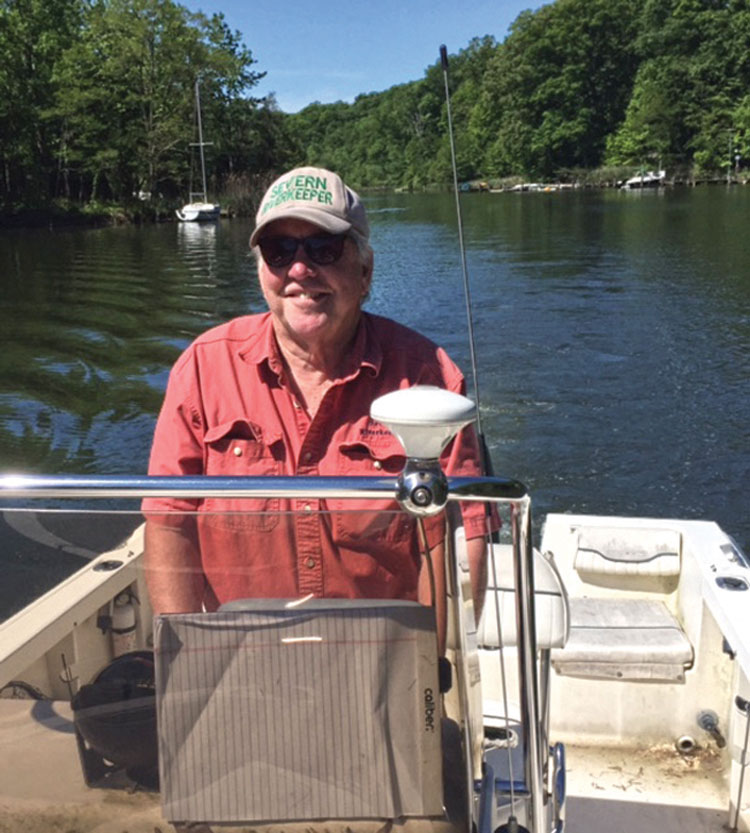If you live on the Chesapeake around Annapolis, or if you crab or fish or sail here, you’ve probably noticed something remarkable over the last few years. It’s actually cleaner!

No, you’re not imagining things. At least not according to Severn Riverkeeper Fred Kelly, who stares downriver at the Route 450 Bridge from his cozy cottage at the mouth of Saltworks Creek and likes what he sees—more aquatic grasses, clearer water, more fish, even a few oysters.
Kelly, 71, is retired from a career as an environmental lawyer, but he still butts heads with bureaucrats, developers, businesses, and homeowners whose activities for decades have been making the river a little dirtier, day by day. The tide, he says, is finally changing.
Kelly is so bullish on the improving status of the Severn that he believes within a decade it will be “fully restored.” What does that mean? “It means dissolved oxygen levels will be high enough to support healthy aquatic life, and we’ll reduce the sediments and nutrients and bacteria” that foul the troubled waterway.
The Severn is unique among mid-Bay rivers, Kelly says, as the only one with its own “dead zone”—a patch of deep water in Round Bay where oxygen levels go to zero in the heat of summer. Other dead zones are in the depths of the Bay proper. But Round Bay’s is getting smaller, and it arrives later and ends earlier.
These and other encouraging data bits come from weekly summer surveys Riverkeeper intern Nate Frankoff runs for Kelly at 15 sites on the river where he tests for dissolved oxygen, clarity, and temperature.
So why the positive change and high hopes? Kelly says it’s all about money, specifically tax money from two relatively new sources: the county’s so-called “rain tax” and the state “flush tax.” These funds, along with federal grants from the Environmental Protection Agency and the National Fish and Wildlife Administration, provide millions to pay for projects that reduce nutrients, sediments, and bacteria washing into the river.
Kelly was moved to take up the cudgel for the Severn years ago when he saw an aerial photo after a storm. A plume of brown muck descends from the headwaters all the way to Annapolis. Kelly keeps that photo, enlarged to poster size, on hand for inspiration.
He’s convinced restoration funds being used by the state Highway Department to stop sediment washing off Route 32 and I-97 have already had a positive effect. Meanwhile, he’s led small projects at the headwaters of creeks and branches to slow stormwater runoff, while federal and state funds have reduced nutrients from public sewage plants and failing septic systems.
Kelly’s role is to keep the pressure on. When he rides up and down the river in his center-console skiff, he’s looking for trouble. It may be signs of homeowners cutting trees in critical areas or collapsing bulkheads that could be replaced by a “living shoreline” of marsh grass to slow runoff and gobble nutrients. He’s not afraid to make a fuss.
“We look around for violations and when we find one, we report it to the county, which is often not responsive, or to the state Department of the Environment, which is better. We did get the county to prosecute a guy who was cutting down trees in Olde Severna Park, and that sent a message. And we sued the state when they wouldn’t give us permits for a project to restore wetlands on Chase Creek.”
It’s done on a modest budget of about $125,000 a year, all donations, including $40,000 from 40 donors who pledge $1000 a year. “It’s pennies compared to the Chesapeake Bay Foundation,” where Kelly once worked as a lawyer, “but we leverage that to raise millions of dollars for restoration projects that actually stop pollution.”
Kelly is perhaps most pleased with a project he headed to slow stormwater from Annapolis Mall running into his home creek, Saltworks, and another to moderate the flow into neighboring Clements Creek from the Carriage Hills development. These are the rock-and-pool watercourse projects of the kind you sometimes see from highways, designed to slow stormwater so it drops sediment and pollutants before they get to the Bay.
Each is a drop in the bucket, but when you add it up—reduced nutrients from sewage treatment plants and septic systems, reduced sediments from highways, malls, and communities, natural shorelines to reduce erosion, and protection of forest and marsh—things start looking up.
Kelly loses me when he envisions a “fully restored” Severn in 10 years. As long as the population keeps growing, I doubt we’ll again see fields of aquatic grasses in the shallows or water so clear you can pick out the perch you want by glancing over the side of the boat. But things are definitely getting better. You can’t knock that.
Visit severnriverkeeper.org.
by Angus Phillips




